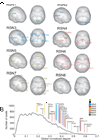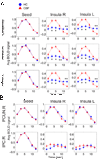Brain resting state is disrupted in chronic back pain patients
- PMID: 20800649
- PMCID: PMC2954131
- DOI: 10.1016/j.neulet.2010.08.053
Brain resting state is disrupted in chronic back pain patients
Abstract
Recent brain functional magnetic resonance imaging (fMRI) studies have shown that chronic back pain (CBP) alters brain dynamics beyond the feeling of pain. In particular, the response of the brain default mode network (DMN) during an attention task was found abnormal. In the present work similar alterations are demonstrated for spontaneous resting patterns of fMRI brain activity over a population of CBP patients (n=12, 29-67 years old, mean=51.2). Results show abnormal correlations of three out of four highly connected sites of the DMN with bilateral insular cortex and regions in the middle frontal gyrus (p<0.05), in comparison with a control group of healthy subjects (n=20, 21-60 years old, mean=38.4). The alterations were confirmed by the calculation of triggered averages, which demonstrated increased coactivation of the DMN and the former regions. These findings demonstrate that CBP disrupts normal activity in the DMN even during the brain resting state, highlighting the impact of enduring pain over brain structure and function.
Copyright © 2010 Elsevier Ireland Ltd. All rights reserved.
Figures




References
-
- Apkarian AV, Sosa Y, Krauss BR, Thomas PS, Fredrickson BE, Levy RE, Harden R, Chialvo DR. Chronic pain patients are impaired on an emotional decision-making task. Pain. 2004;108:129–136. - PubMed
-
- Apkarian AV, Bushnell MC, Treede RD, Zubieta JK. Human brain mechanisms of pain perception and regulation in health and disease. Eur J Pain. 2005;9:463–484. - PubMed
-
- Beckmann CF, Smith SM. Probabilistic independent component analysis for functional magnetic resonance imaging. IEEE Trans Med Imag. 2004;23:137–152. - PubMed
Publication types
MeSH terms
Substances
Grants and funding
LinkOut - more resources
Full Text Sources
Other Literature Sources
Medical

